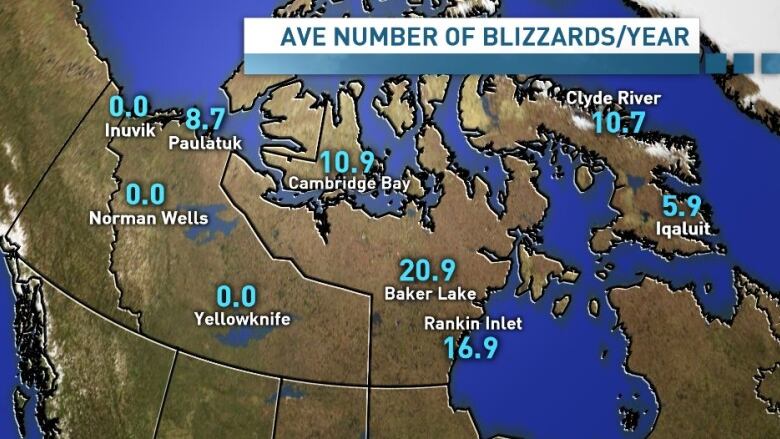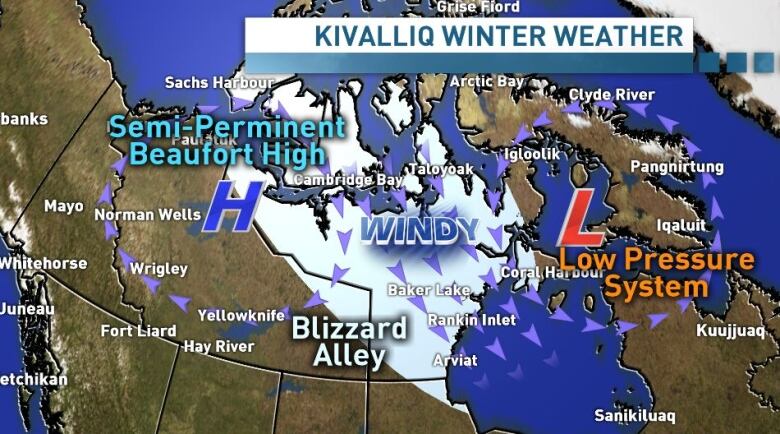Welcome to the Kivalliq, Canadas blizzard capital
Baker Lake receives more than 20 storms that qualify as blizzards each winter season

By pretty much any measure, Nunavuts Kivalliq region on the West coast of Hudson Bay, has a special distinction Canadas blizzard capital.
Anyone who has flown through the region can attest to this. Conditions can be clear on landing, but a short time later, blizzard conditions can popup and rage for days, stranding flights, frustrating passengers and shutting down communities.

A blizzard is completely dependant upon the visibility in an area. In order for a blizzard to occur, acommunity must see six consecutive hours of visibilities under 400 metres due to blowing snow above the tree-line (Nunavut), and four hours of low visibility below the tree-line (in southern Canada, the Yukon and most of the N.W.T.). This means that blizzard conditions are possible in an area with no falling snow, provided that the winds are strong enough to cause those white-out conditions.
Although blizzard criteria are met after six hours in the Kivalliq, blizzards often rage for much longer than that. One storm can easily last for three or four days in areas like Baker Lake, keeping people indoors and businesses closed.
In 2008, a blizzard raged in Rankin Inlet for seven days and five hours.
The Kivalliq region receives the most blizzard events each year in all of Canada. Baker Lake receives more than 20 storms that qualify as blizzards each winter season, according to Nav Canada records. That equates to more than 200 hours of blizzard conditions on average per year according to the Meteorological Service of Canada. Thats double the number of blizzards that an area like Clyde River, Nunavut,sees on average per year.
Why so many?

In the the winter, high pressure develops over the Beaufort Sea (known as the Beaufort High). This high pressure system is called a semi-permanent pattern because of its frequent presence in the area during the winter months. Since the edge of this high pressure system sits near the Kivalliq (just northeast of the treeline), any low pressure systems in the Eastern Arctic will cause a rapid change in pressure in that corridor.
This pressure change drives very strong winds in the region, which in turn drive enough blowing snow for persistent blizzard conditions. Because this weather pattern is relatively stable (due to the frozen High Arctic and open oceans to the west and east), these blizzard conditions can persist for days.
Adding to all that is geography the Kivalliq region is flat. In a recent interview, Dave Baggaley, a meteorologist with Environment Canada, explained how this terrain can encourage windy weather.
In a forested area, winds down at ground level just do not get very strong and sustained blizzards in a forest is very unusual, he said. But, the terrain over the Kivalliq is pretty flat and mostly barren. That does have a major effect on the occurrence of blowing snow.
People in Baker Lake NU have even built a large snow fence, to try and cut down on the windy weather.
The final reason for all the blizzards is simply the length of the winter in the Kivalliq. Blowing snow is more likely to occur at cold temperatures.
The most favourable temperature for blowing snow is around -28 to -30 C. Kivalliq sees the very cold temperatures much more frequently, Baggaley says.
All this means blizzard conditions are and will continue to be a frequent occurrence in the Kivalliq region. Calm winter days are few and far between in the area, so enjoy them while they last!












_(720p).jpg)


 OFFICIAL HD MUSIC VIDEO.jpg)
.jpg)



























































































